#class of 1894
Explore tagged Tumblr posts
Text

On January 20, 1898, Princeton University alum George White, Class of 1894, was dropped off on a remote Alaskan shore alongside other prospectors in the Klondike Gold Rush. They set forth on a 30-mile journey on foot through the Chilkoot Pass that would ultimately take three months. Unlike most prospectors, White succeeded in finding the minerals he sought.
The image shows the foot traffic up the Chilkoot Pass in 1898 from a stereograph in the Princeton University Library Collection of Western Americana Photographs (WC064), Box S4, Folder S0648.
#Gold Rush#Klondike Gold Rush#Canada#Alaska#Princeton#PrincetonU#Princeton University#Class of 1894#1890s
3 notes
·
View notes
Text
seeing this pic all i can focus on is the dresses of the woman and girl on the left. <3333

#z xarre#like. this is from 1894. and now the way these women dress (the ones on the right are higher class than the ones on the left) is how you dr#how you dress for the flower offering on october 12th (a very special day aka el dia del pilar)
3 notes
·
View notes
Text
This is 1890’s film erasure. Anyway for y’all’s viewing pleasure go watch the earliest surviving copyrighted film: Record of a Sneeze
#reblog ʕ⁎̯͡⁎ʔ༄#I remember having to watch this in a film history class#and honestly given that it’s from 1894#it’s really tellreally good
459 notes
·
View notes
Text
Study Session | Kim Gyuvin
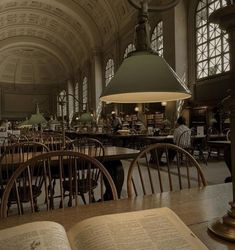


Summary: When exam season rolls in and you have to study with your boyfriend, it takes an unexpected turn. From a simple study session to having to stay quiet, it's guaranteed to fail your upcoming exams.
Pairing: Female reader x Kim Gyuvin
Genre: Smut (as usual, Minors DNI)
Word count: 1894 (DAMN I ATE-)
Warnings: SoftDom!Gyuvin being gentle at first but him being a meanie later on, pussy eating, spitting on clit, lots of praise, pet names (bun, bunny, baby, pretty), orgasm denial
Notes: I got an ask for this and my brain already knew what I'm gonna write so...enjoy! (Tea finally writing with no break wow give a ROUND OF APPLAUSE) ALSO WE HIT 1K WHO CHEERED!!

Exam season was coming up. Materials kept piling up for every subject every time you had a class, and it wasn't helping that every exam was back to back. Of course, it was stressful with how much you had to work on, but Gyuvin was always there to help you out.
Luckily, you were both in the same class, so having study dates was guaranteed since you both were together, with everyone calling you the cutest couple. You spent almost the whole week at the library, with you helping out Gyuvin and him doing the same.
The material was surprisingly easy, despite the both of you thinking it would be hard. Well…some of the material was hard for a few subjects, but other than that, every study session went well with ease.
It was one of those days again, being stuck in the library yet again with him. You had a massive headache and as much as you wanted to focus on the subject, you couldn't. Gyuvin was already halfway done with his materials.
You stopped reading through the materials and let out a sigh, your body slumping against the chair, clearly feeling emotionally drained and exhausted from how much you had left. He turned his head slightly, just to take a glance at you, noticing how tired you were.
That quickly made him stop, dropping his pen as he turned to you and cupped your face with his hands, feeling the heated skin of your flushed cheeks and seeing your eyes were half-lidded, your lower lip pushed out as you pouted, your brows furrowed slightly as you looked at him, seeing the fond expression on his face as he took in every detail of your face.
“Are you feeling tired, bunny?” He asked, his thumbs pressing slightly into your skin and starting to rub small circles against your cheeks as you hummed in response, letting him soothe you.
“I know how much you hate studying, and I do too. But we both need to do well next week, okay?” He encourages you, as he leans in and starts leaving small kisses all over your face, trying to get you more motivated to finish studying.
“You're my pretty and smart girl, yeah? My good girl, always studying on time.” He coos as he keeps kissing your face, making sure his lips cover your forehead, cheeks, nose and lips, repeatedly pecking them as you enjoyed the feeling of his lips against yours.
He pecked your lips a few more times before pulling away, but he was caught off guard with the way your hand moved up his chest, watching how you gripped the collar of his shirt before pulling him back in, letting your lips crash against his as you shared a kiss.
He quickly melted, his hands still cupping your cheeks as he kept the kiss going. After a minute or two he pulled away, a smile forming on his lips as he stared at you, seeing how much a simple kiss made you look so relaxed and content while you looked at him, clearly wanting one more kiss.
He chuckled as he noticed how your eyes moved down to his lips for a few seconds before shooting back up, making eye contact with him again as you silently begged for just one more kiss.
“Nono, you need to study now, pretty.” He says and leans in, kissing your forehead as he lets his lips linger against your skin for a few seconds. He pulls away and gently pats your cheek, before letting go of your face and turning back to his open notebook.
He picked up his pen and started writing down more notes once again, leaving you wanting more kisses as he resumed from where he last left off. You let out a sigh, feeling slightly disappointed but more productive thanks to him as you looked at your notes and started reading through them again.

30 minutes have passed. Gyuvin was already finished with revising and was just waiting for you, his eyes fixed onto you as he watched how focused you were. He found it cute how focused you'd get whenever you studied, and it made him want to just kiss you and catch you off guard.
He kept waiting, slowly starting to get bored while you wrote in your notebook, trying your best to revise everything from the provided material since you weren't planning to fail any of the subjects. It made him feel a bit needy, seeing the way you bit the end of the pen while you were thinking, your pretty lips covered with his favorite lip gloss and the way you sighed every few minutes.
He couldn't wait anymore, he got more and more impatient with the way you were barely paying him any attention. He leaned in and nuzzled his face against the crook of your neck, making you hum softly at the sudden closeness.
“Pretty…” He whispered softly, his warm breath tickling your skin as you kept reading through the material, not giving him attention at all. He sighed impatiently, as he pressed his lips against your neck and started leaving small kisses, your grip on the pen becoming more firm as you tried not to squirm.
“Are you almost done, bunny?” He asked as he kept peppering your neck with gentle kisses, and it made your stomach clench from the sound of his voice. The only response you could give was a small “Mhm” which didn't satisfy him, as he moved his lips higher, letting them linger against your jawline.
“You look so pretty right now, baby…” He mumbled against your skin as he started leaving tiny kisses along your jawline, making you become a bit unfocused as you glanced at him, finally paying him a bit of attention that he craved.
“Baby…I can't right now.” You said quietly as you tilted your head to the side slightly, but he quickly interrupted that by grabbing the side of your neck and holding you in place, as he kept kissing your jawline.
“I know, but I need you, bun…” He whines softly against your skin, your stomach starting to twist from how hot it sounded, but you were determined to keep studying, so you ignored him once again, earning another sigh from the poor boy.
“Come on…you're not being fair…” He whines even more, trying to grab your attention once again, and it was already clear how much he was getting hornier by the second.
“Just wanna have a quickie…please?” He pleaded, the desperation evident as he tried to persuade you.
“I promise I won't bother you after this, baby, please…” He kept begging and grabbed your free hand, stopping you from studying as he moved it to his crotch and placed it directly on his bulge, letting you feel how hard he was.
“You feel that, bunny? I'm so fucking hard right now.” He says, his breath hitching as he moved your hand against his bulge, the warmth of your touch making him needier.
He was about to speak again but he was taken aback when you suddenly slapped his bulge and moved your hand away, causing him to grunt in discomfort as he glared at you, meanwhile you glanced at him.
“What was that for?” He asked, sounding surprised as he tried to recover from the sudden pain, not expecting you to get bold with how he basically clinged onto you, begging for more attention.
“Just a little warning…in case you forgot I had to study?” You said, the way you acted and sounded was like how a brat would, which made him start to get a bit pissed as you turned back and started studying again.
“You wanna study? Then I'll let you study.” Gyuvin said sarcastically as he slipped underneath the table, kneeling in front of your legs as he placed his hands on top of your thighs, causing you to tense up from the sudden touch.
He smirked and let his hands slip beneath your skirt, moving them upwards as he leaned in and started kissing your thighs, his breath hot against your skin as he watched the way your legs spread instinctively.
His fingers hooked into the waistband of your panties as soon as his hands reached your hips, as he carefully slid the fabric off of you, leaving your pussy exposed as soon as he took off your panties fully.
You didn't even dare to look down at him, realization sinking in as he put your panties in his pocket, while letting his hands slide down to your inner thighs, gripping them gently as he leaned in, his warm breath fanning against your folds, tensing up even more when his lips latched onto your clit, starting to suck gently.
You bit your lower lip, doing your best to stifle your moans as you tried to study again, but with the way he kept sucking on your clit made it impossible. He pulled away slightly, letting go of your clit as he gathered saliva in his mouth and spit directly onto your clit, causing you to hiss in discomfort at the warm and wet feeling.
He watched how his saliva glided down your folds, seeing the way you clenched around nothing as soon as you felt it slip inside, making your juices gush out and mix with the saliva. It dripped down from the chair directly onto the floor, making him grunt at the sight as he leaned back in and started licking at your hole.
Your thighs twitched in his grip, and he knew that you were getting a bit sensitive. He kept licking at your hole, letting his tongue glide up and down, while you kept studying despite the struggle. No matter how much you tried to read through your notes, it all became a blur with the way he was pleasuring you.
He pulled away slightly, letting his tongue glide from your gushing hole to your clit, then latched his lips onto it again, earning a shaky sigh from you. It made you lose your focus completely, now ignoring the materials as you let your hands drop to your sides, sluming once again against the chair.
“M-more…” You begged, trying not to sound desperate as he moaned against your folds, clearly enjoying how wet you got the more he kept licking and sucking. He kept going, his mouth and tongue working skilfully on you as you neared your orgasm, and just as you were about to cum he stopped and pulled away, causing you to whimper from the sudden loss of pleasure.
“Ah, ah…You need to study, bunny…You don’t want to fail your exams next week, right?” He said, coaxing you into studying again, which made you let out a sigh in frustration.
“B-but…I was close!” You whined, clearly frustrated with him as you looked down at him, a frown forming on your lips. He looked up at you and smiled innocently, and you became aware that he wouldn’t dare let you finish in peace.
“I dunno what you’re talking about, bun. You should study, yeah?” He coaxed gently, as he leaned in slightly and kissed your inner thigh, making you reluctantly nod in agreement.
That’s how you knew you fucked up, and with the way he was acting, you were in for a sleepless night.
#zb1 hard hours#zb1 hard thoughts#zb1 smut#zerobaseone hard hours#zerobaseone hard thoughts#zerobaseone smut#kpop hard hours#kpop hard thoughts#kpop smut#gyuvin hard hours#gyuvin hard thoughts#gyuvin smut
291 notes
·
View notes
Text
Hogwarts Fashion During Hogwarts Legacy
A cheat-sheet for making your writing/art historically accurate, and some inspiration for your MC - women's addition.

Victorian fashion was complicated, both in terms of the construction and the rules that dictated when certain garments could be worn. Age played an important role in what a person was permitted to wear, so lets break it down that way:
Younger Students (Roughly years 1-4)
Generally speaking, girls dressed in similar styles to their mothers, but with altered hemline lengths. Up until roughly 13-14 years old (exact ages were decided by the girl's family) her hemline would fall around the knee. At 14 it would be lowered to the middle of the shins.
At this age girls would wear dresses, and so you could suggest that Hogwarts uniforms for girls at this age would not consist of the shirt and skirt combo that MC and various NPCs wear.
Most schools in the 1890s did not have set uniforms, but instead girls were expected to wear an apron to protect their clothes from ink and chalk dust.
At this age it was still considered socially acceptable for girls to wear their hair down, or in more simple hairstyles like braids. Popular hair accessories included ribbons and straw hats.
Time for some examples:
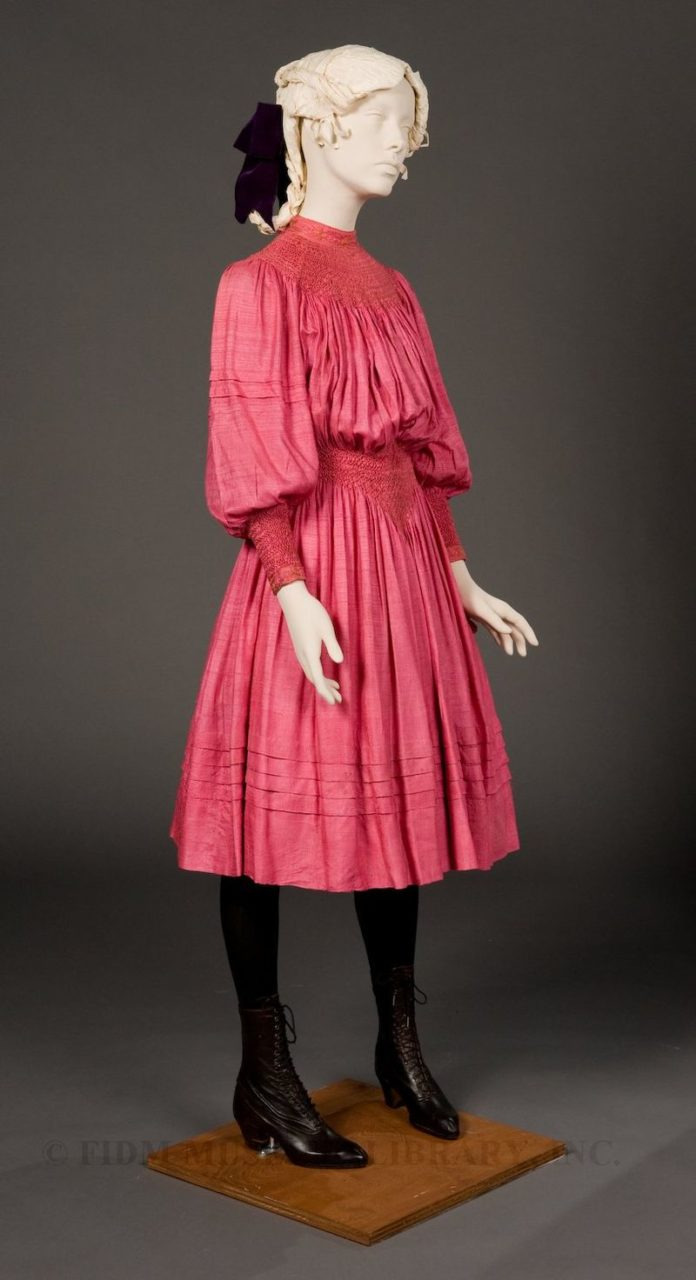
This is an example of a day dress (casual clothes) from 1893. Smocking (the embroidery technique used at the collar, waist and cuffs) was popular in young girls clothes.
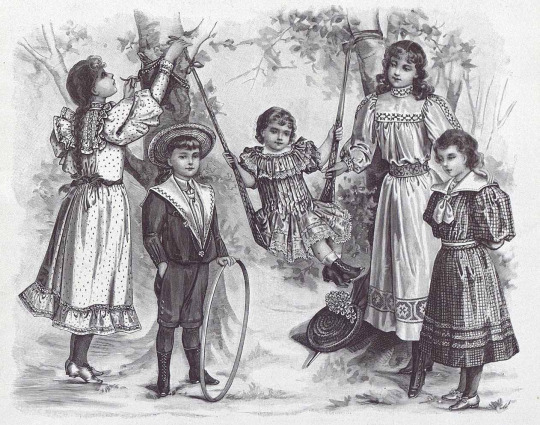
Another example of children in day dress. The girl on the far left is probably about 13-14, the older girl on the right is closer to 15.
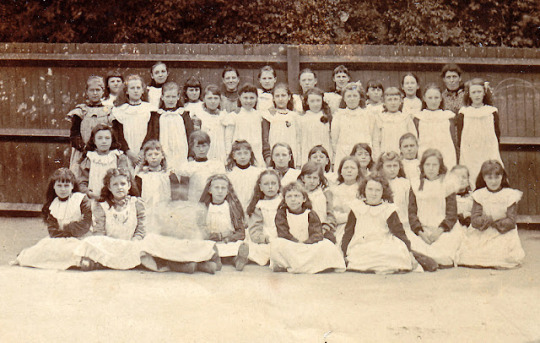
An example of the aprons worn by younger students.
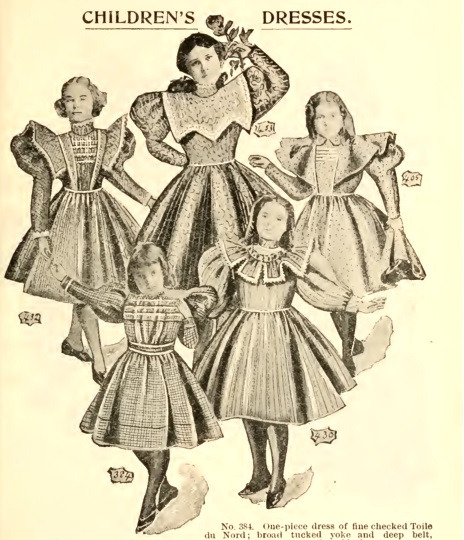
Details of the dresses worn underneath (technically from 1897 but the styles are fairly similar)
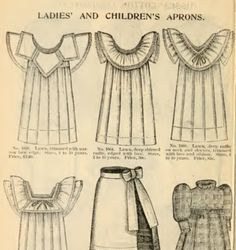
Details of the aprons worn
Older Students (Roughly years 5-7)
Around the time that the MC joins at Hogwarts, she would, depending on her personal preferences, have kept her skirt at her mid shin or dropped the hem to her ankles. Around the age of 17, girls would be expected to fully let down their hems to the floor, signifying their shift to adulthood.
At this point dresses would become less popular during the day, and were replaced by blouses (complete with very large sleeves) and a skirt. Men's tailoring and sports clothes shaped women's fashion at the time, and greatly influenced what girls wore at this age.
Girls would also typically stop wearing their hair down during the day, resorting to simple up-dos instead.
The time at which each girl made these changes depended on her and her family. While some girls had no choice but to listen to their parents, often they were able to bargain for an extra few months if they so wished.
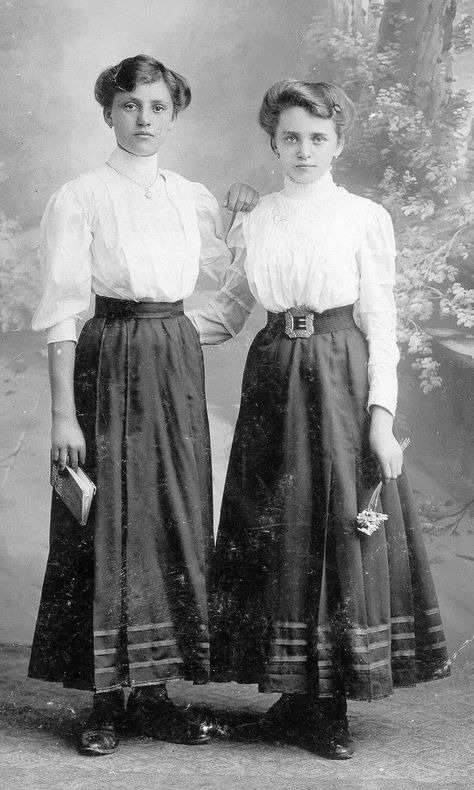
An example of two girls around the age of 15 in very typical day outfits.
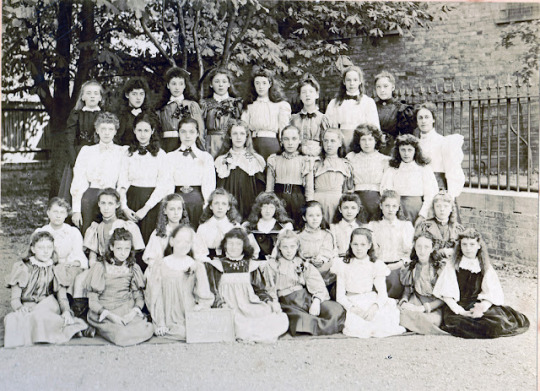
A selection of school girls - those sitting are no older than 14, those standing are no older than 16.
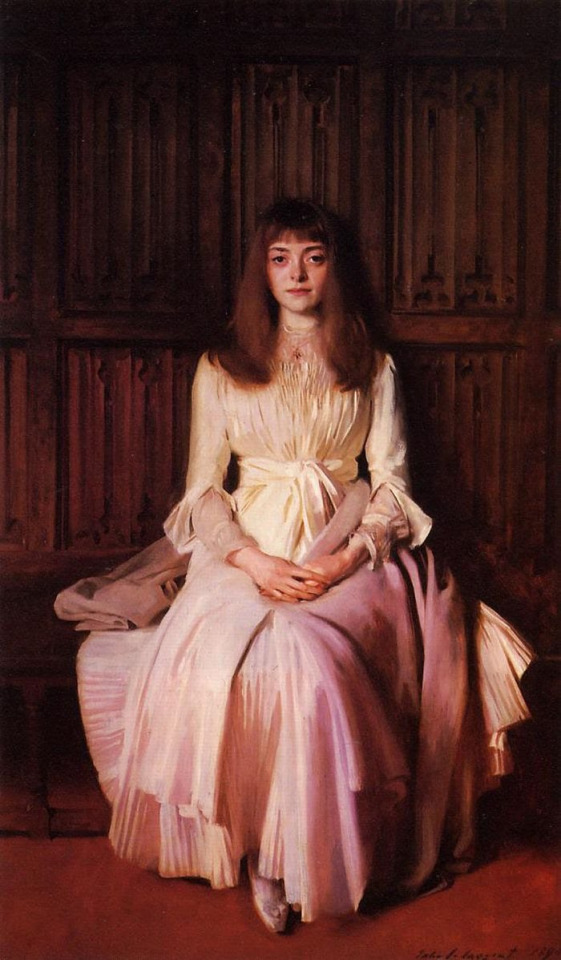

At the age of 15-16 girls would begin to attend more family functions and required new styles of clothes. These paintings show the same tea gown. These were made to be worn at home, never in public, when the family was hosted guests or a less formal dinner. They could be worn at all times of the day.
Day clothes for students who dressed as adults (17+):

A British Upper VI class (age 17-18) and some teachers in 1894. All girls now wear dresses with their hems on the ground, and hair tied up.
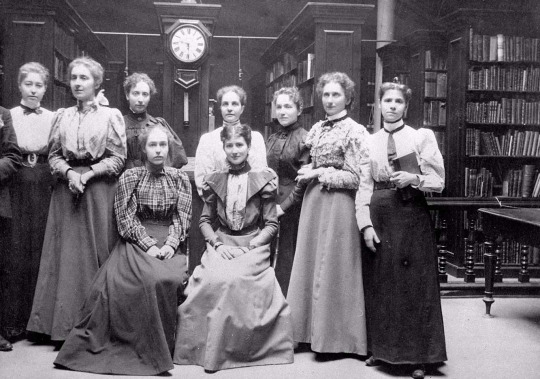
Middle class girls fashion in the 1890s
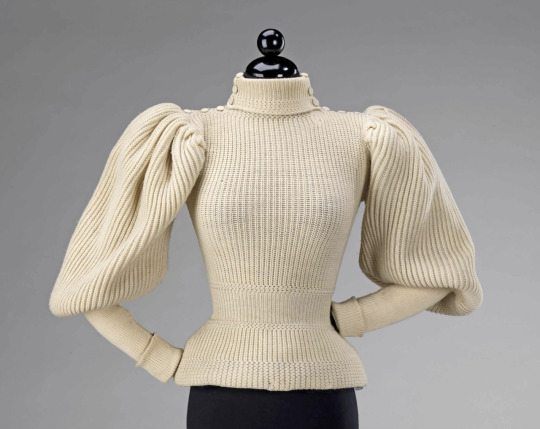
A Woman's sweater from 1895
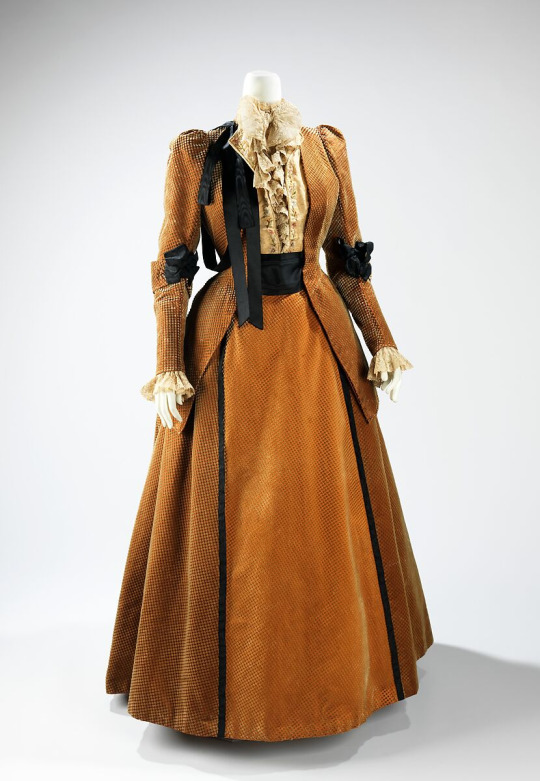
Walking outfit from 1894 - essentially a more substantial outfit for spending time outdoors.
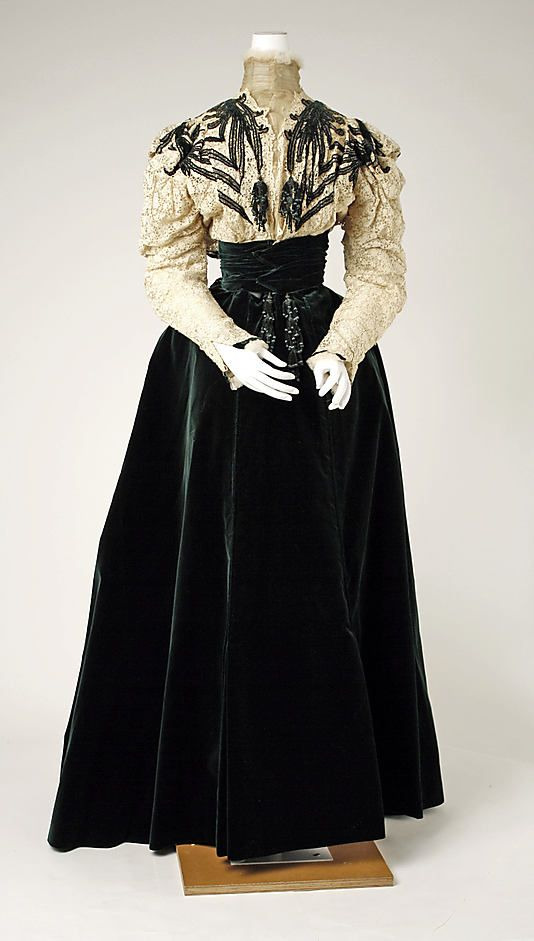
A more expensive version of a day outfit.
Tea gowns:
Generally identified by their loose fit, high neckline, and a train that falls from the shoulders. Additionally they may also be made with a large coat over the top. The shape was inspired by medieval fashion and so they're a good source of inspiration for the wizarding world imo.
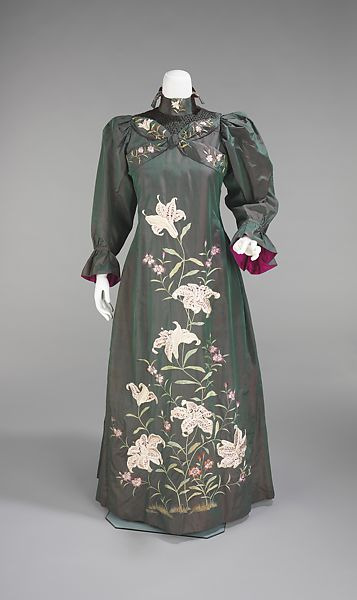
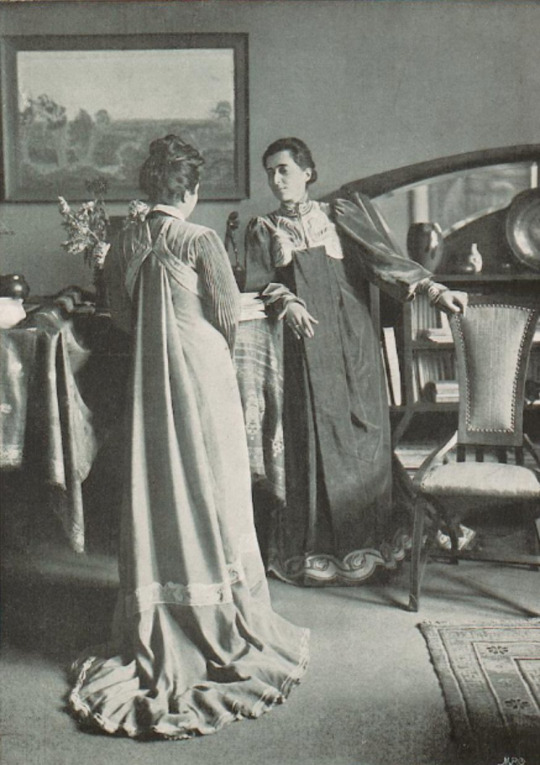
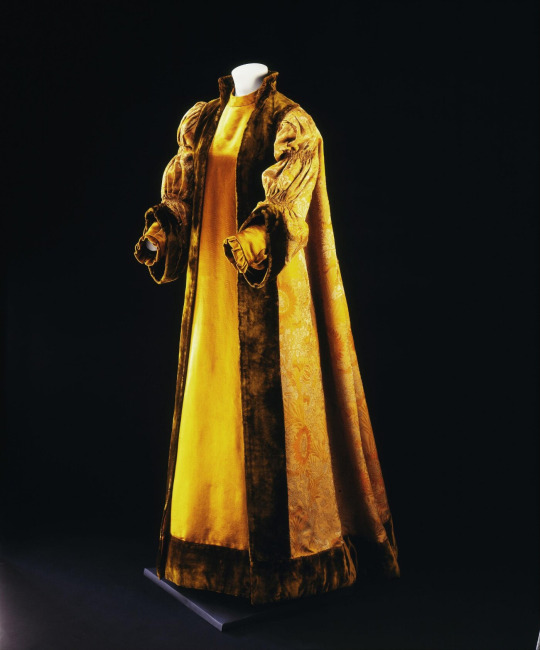

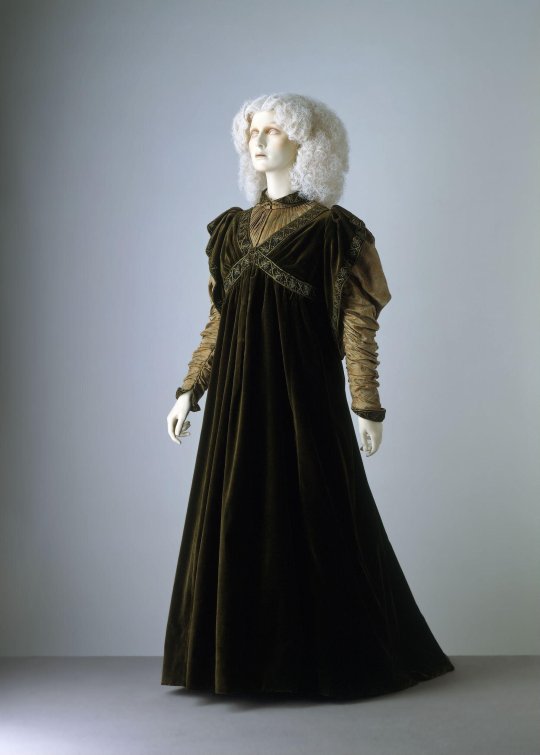
Evening gowns:
Worn for the most formal evening events, and generally expose more skin than day clothes. Staple accessories included fans, opera gloves, and (if you're that way inclined) tiaras were coming into popularity at this time.
Rule of thumb for all fashion at this time, the sleeves get largest in the middle of the decade, and shrink back down again towards the end.

1894
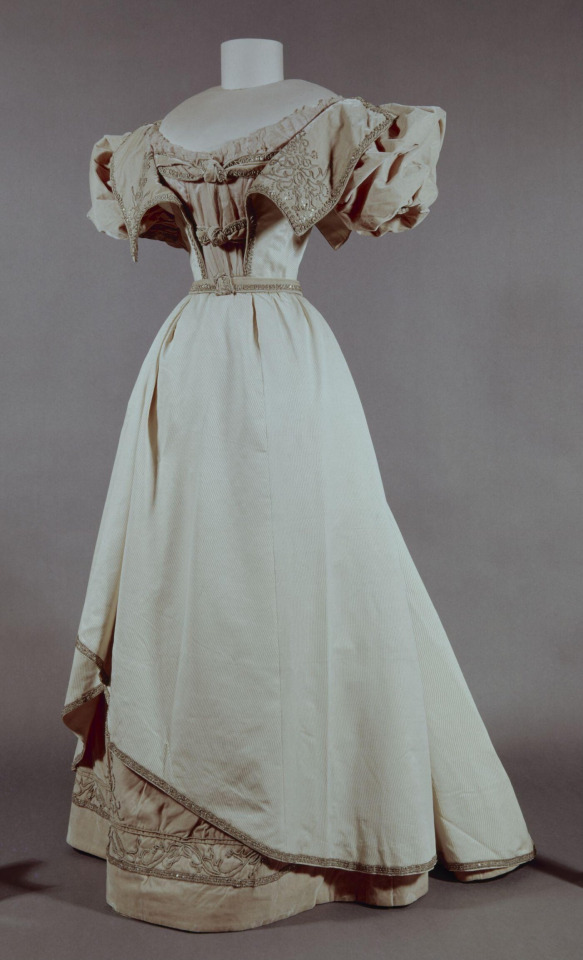
1893
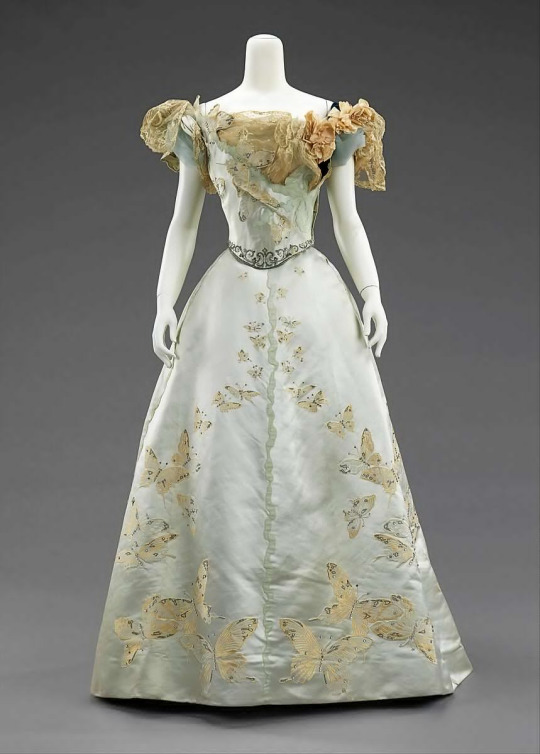
1898

1893-1895
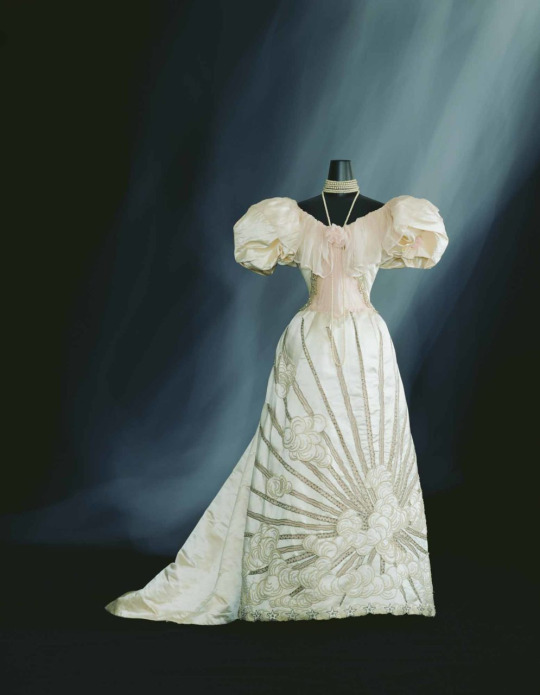
1894

1898
#Wow first post on this account is the nerdiest thing i could possibly pick#enjoy!#hogwarts legacy#harry potter hogwarts game#sebastian sallow#sebastian sallow x mc#sebastian sallow x you#sebastian sallow x reader#ominis gaunt#ominis gaunt x you#ominis gaunt x reader#garreth weasley#garreth weasley x mc#garreth weasley x reader#ominis gaunt x mc#hogwarts legacy art#hogwarts legacy mc#historical references#fashion references#1890s
2K notes
·
View notes
Photo

The Murder of the Romanov Family
The brutal murder of the entire Romanov family was the culmination of deep discontent across the Russian Empire with the persistently autocratic rule of Tsar Nicholas II (reign 1894-1917). Following the disaster of the First World War (1914-18) and the tsar's abdication in 1917, Bolshevik revolutionaries took power. The new Soviet Russia was immediately split by a raging civil war, and as royalist sympathisers neared Ekaterinaburg (Yekaterinburg), where the Tsar, his wife, and their five children were being held, the Bolshevik leader Vladimir Lenin (1870-1924) ordered their execution. On 17 July 1918, all seven royals were shot and their bodies were then secretly buried. DNA testing has confirmed the remains of all seven members of the Imperial family.
An Unpopular Tsar
Tsar Nicholas II had reigned as the absolute ruler of the Russian Empire since 1894. Economic problems, societal changes, and a significant growth in the population, which resulted in land shortages, all combined to inspire certain groups to demand reforms. The tsar barely escaped being toppled by the Russian Revolution of 1905. The massacre of unarmed protestors, known as Bloody Sunday in 1905, kicked off a series of state-wide strikes and protests that year, which were supported by all classes of Russian society. The tsar's half-hearted attempts at political reforms with a new representative parliament, his choice of reactionary ministers, and the lack of significant success concerning the Stolypin Reforms, that is social, economic, and land reforms instituted by the prime minister Pyotr Stolypin (1862-1911), meant that revolutionary sentiments continued to bubble under the surface of Russia's autocratic rule. Assassinations, including that of Stolypin in 1911, and activism by Communist groups like the Mensheviks and Bolsheviks, kept the idea of change at the forefront of Russian politics. Another source of criticism towards Nicholas II was the mysterious role of the self-proclaimed holy man Grigori Rasputin (1869-1916) and the question of just how much influence this Siberian peasant had on the royal family.
Although the Russian peasantry still widely respected the sanctity of the tsar's role, Russia's entry into the First World War (1914-18) was disastrous for Nicholas II and proved to be the last straw for the revolutionaries. Once again, as had been the case following the humiliating defeat in the Russo-Japanese War (1904-5), Nicholas was exposed as an incompetent war leader, even if he himself had been reluctant to enter this particular conflict. Nicholas' decision to take over as commander-in-chief of the armed forces in September 1915 meant that he became closely associated with Russia's military failures. These failures included calamitous defeats on the battlefield, disastrous logistical incompetence, and the deaths of over 2 million Russian soldiers. WWI also caused further woes for the Russian agricultural sector and economy in general.
The ultimate result of all of this strife was the Russian Revolution of 1917 (actually two revolutions), which began with bread riots in Petrograd (Saint Petersburg) in March 1917 and which quickly escalated when troops of the Petrograd garrison joined the rioters. The revolution and the lack of support for the tsar amongst the political elite forced Nicholas to abdicate on 2 March; he also abdicated in the name of his son and heir, Alexei. Still not quite grasping that the Romanovs were about to disappear from history, Nicholas chose his brother to succeed him, Grand Duke Michael Alexandrovich (1878-1918), who reigned for just one day as Tsar Michael II, although he was never officially confirmed as such. The Bolsheviks ensured that the Russian monarchy was effectively abolished.
Nicholas was advised to flee the country for his own safety, but he refused, stating, "I'd never leave Russia. I love her too much" (Montefiore, 629). Nicholas entertained the idea, rather naively, of living a quiet life of retirement in Crimea (where his mother was) or Kostroma, which had historical ties with the Romanovs.
Read More
⇒ The Murder of the Romanov Family
87 notes
·
View notes
Text

HAPPY PRIDE MONTH
As every year this is a good date to remember the daily struggle for the rights of the LBGT+ community. It is also a time to learn about the people who made it possible for us to identify ourselves as who we are today without fear of reprisals or being punished by the law. This month I got involved in the history of Argentina and its different movements for the fight for rights through the 20th century. Here I come to share some important figures, some more known than others, but obviously there are a lot that I have left out of this publication.

Sara Facio (1932-2024) & Maria Elena Walsh (1930-2011)
A couple of intellectual artists that would need a separate publication to go deeper into the subject. Sara is one of the greatest Latin American photographers who with her camera contributed to the creation of the most outstanding photographic heritage of the country. Maria Elena is a writer, singer and composer whose children's songs resonate to this day because they are much more profound than they seem and are still relevant today.
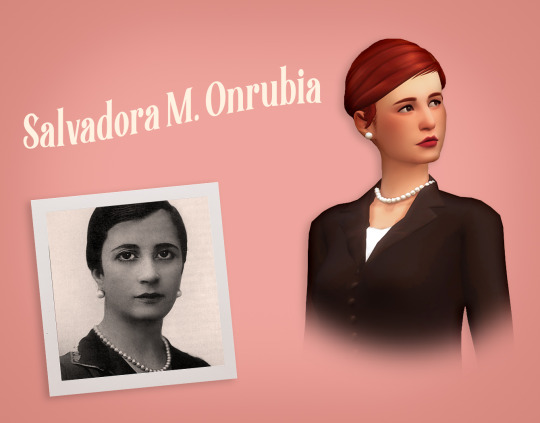
Salvadora Medina Onrubia (1894-1972)
She was a writer, militant anarchist, single mother and the first woman to run a newspaper in the country. She was the first Argentinean woman to dare to write about double sinners, lesbians and adulteresses. One of her most valued plays was Las descentradas, premiered in 1929. There, Salvadora honors her own contradictions, narrating women who question monogamous structures, marriage and the traditional family.

Malva Solis (1920-2015)
She was a transvestite writer who lived for 95 years when the life expectancy of this community in the country was under 40 years old. In 1951 founded the first trans organization on record, Maricas Unidas Argentinas. She has the oldest series of trans photographs in the country, dating from 1940 to 1980, when simply having those photographs at home was cause for being arrested. There is a documentary based on the photographs and conversations with her at her home called "Con Nombre de flor".
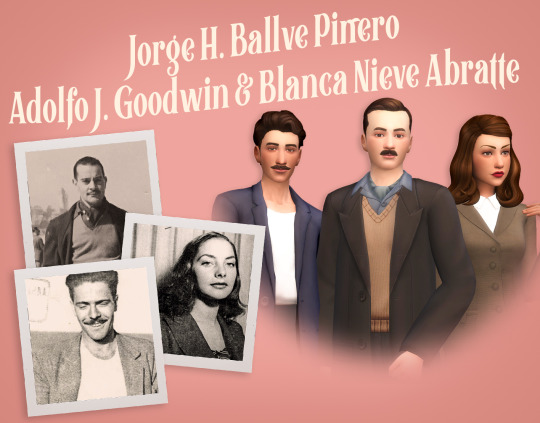
Jorge Horacio Ballve Piñero (1920-?)
Piñero was a young man from a well-to-do family of the Buenos Aires society at the beginning of the century. Together with his best friend Adolfo and Blanca, he organized gatherings in his apartment in Recoleta, and was a pioneer of male erotic photography. They mixed the privileged social class with workers, dishwashers, gas station workers, sailors and cadets from the Military College. These three characters were involved in a police case involving cadets from the military college, known as the Cadet Scandal. In the police archives remain captive the photographic collection, intended for pleasure and personal aesthetic enjoyment that tragically proved key to incriminate some friends who just wanted to have fun.
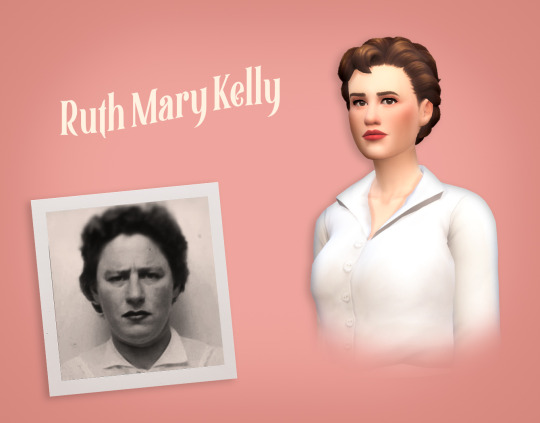
Ruth Mary Kelly (1925-1994)
She was a bisexual woman, who worked as a "Wohoo Worker". Founder of Grupo Safo in 1972, the first Argentine lesbian organization, and of the Frente de Liberación Homosexual (Homosexual Liberation Front). In 1972 she wrote Memorial de los Infiernos about her experiences as a "Wohoo" worker and bisexual, persecuted by the psychiatric-prison system.

Manuel Puig (1932-1990)
He was an Argentine writer and LGBT+ activist, author of the novels Boquitas pintadas, El beso de la mujer araña (Considered one of the most recognized LGBT works in Latin America and one of the best works in Spanish of the 20th century) etc. He also fought against authoritarianism and machismo, and was one of the founders of the Homosexual Liberation Front in 1971, one of the first associations for the defense of LGBTQI+ rights.
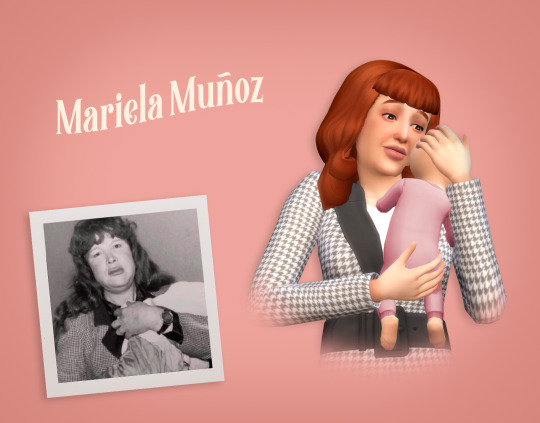
Mariela Muñoz (1943-2017)
She was the first transsexual woman to be recognized by the state and given a female ID card on May 2, 1997. At the age of 16 she became independent, and it was then that she began caring for children, teenagers and single mothers. She cared for children who had been abandoned by their mothers, whom she loved and cared for. She raised, during her lifetime, 23 children and 30 grandchildren. In a dispute over the guardianship of 3 children in 1993, Argentina was confronted for the first time with the debate as to whether a transsexual person "could be a mother"

Carlos Jauregui (1957-1996) & Raul Soria
Carlos was a History professor and the founder of the Civil Association Gays for Civil Rights, organizer of the first Pride march in Buenos Aires and an essential figure for Argentine activism. In 1984, he broke with the schemes by appearing in the magazine Siete Días embracing the activist Raul Soria, a homosexual person assumed his sexuality in a public way for the first time. He believed that media visibility is fundamental for LGTB people. Leaving aside the fear and silence that other generations suffered for years. In 1985, Raul would present himself as the first gay candidate for congressman in the country.

Roberto Jauregui (1960-1994)
Brother of Carlos, was a journalist, actor and the first activist for the rights of people with HIV in the country. In 1989 he exposed the inequality in access to treatment at that time due to the price of medication. He played a central role in marches, actions, talks and interviews to demand human rights for people living with the virus. A well-known phrase of his is "Showing one's face is not easy in a society that discriminates, censures and separates".

Cris Miró (1965-1999)
Cris was the first visible trans people that appeared in the media and broke with the "transvestite" paradigm. A dental student, she got involved in the artistic underworld and later studied classical dance, musical comedy and acting. Her career was meteoric: the popularity of revue theater catapulted her to the small screen where she became a sought-after figure in the most popular programs. On June 23rd, a series about his life inspired by his biography was released, available on Prime Video.

Alejandro Vannelli (1948-) y Ernesto Larresse (1950-)
They were the first couple in the province of Buenos Aires to get legally married on July 30, 2010 after the Equal Marriage Law was passed. They met in 1976 because of a triple A bomb in the theater where Larresse was performing with Nacha Guevara, then he joined the cast of Vannelli. At the beginning they did not like each other because of Vanelli's appearance as a wealthy young man and Larresse was the opposite, but opposites attracted and they were a couple for 34 years.

Norma Castillo (1943-) y Ramona "Cachita" Arévalo (1943-2018)
They were the of South America's first gay marriage on April 9, 2010. Norma and Ramona were married to two Colombians, who were cousins to each other. During the dictatorship they both went into exile in Colombia and there they fell in love and lived their romance clandestinely, until Cachita separated and Norma was widowed by her husband. They lived their love freely and even opened an LGBT discotheque in Colombia. In 1998 they returned to Argentina and began to work in sexual diversity organizations.
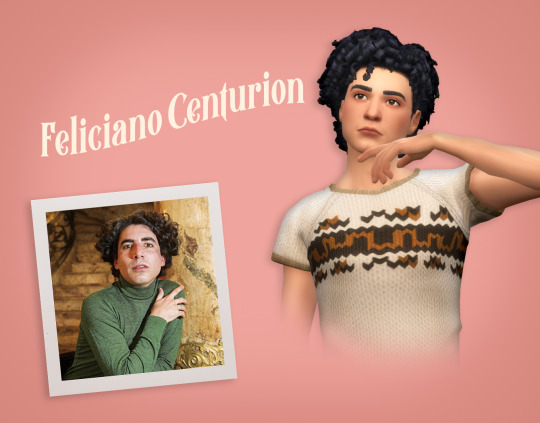
Feliciano Centurión 1962-1996)
He was a visual artist, a Paraguayan painter professionally trained in Argentina. He grew up in a home dominated by women, where he learned to sew and crochet. Inspired by queer aesthetics and folk art, he used to incorporate household textiles and references to the natural world. She handled kitsch art and languages not considered high art with a great deal of knowledge and sensitivity.
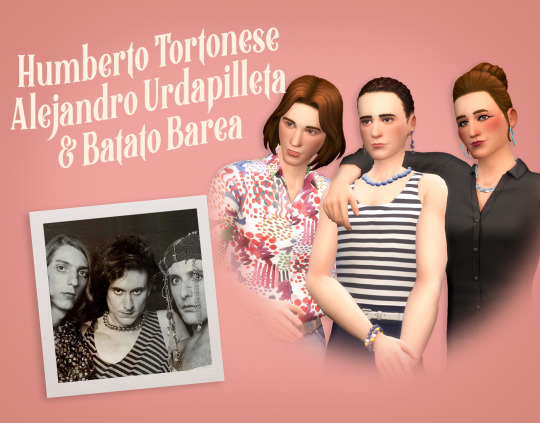
Humberto Tortonese (1964-) , Alejandro Urdapilleta (1954-2013) & Batato Barea (1961-1991)
Batato was an actor and "literary transvestite clown" as he called himself, one of the most important personalities of the underground theater movement of the post-dictatorship years. Together with Alejandro Urdapilleta and Humberto Tortonese, revolutionized the underground scene of the 80's - in places like the Parakultural. They disguised themselves, wore make-up and improvised delirious and strident scenes for the decade.

Sandra Mihanovich & Celeste Carballo
Sandra and Celeste are two singers who were visibly lesbians during the 80s and early 90s. Together they released the albums "Somos mucho mas que dos" and "Mujer contra mujer" which became a symbol of belonging for the whole LGBTQ arc in our country. They managed to be part of the rock scene, an area historically dominated by men. Sandra among all her songs is "Soy lo que soy" released in 1984 composed by Henry Jerman.
#Argentina LBGT#Lgbt Latin America#ARG Queer#lgbt#lgbt love#gay pride#bisexual pride#lesbian pride#pride month#the sims 4#sims 4 pride#sims 4 edit#sims 4 render#ts4 lgbt#lgbt history#queer history#victorian lgbt#PrideFlagLegacy#pride flag legacy challenge#ts4 historical#sims 4 historical#Cris Miro#Sandra Mihanovich#Celeste Carballo#Maria Elena Walsh#Sara Facio#Ballve Piñero#Carlos Jauregui#Roberto Jauregui#Feliciano Centurión
333 notes
·
View notes
Text
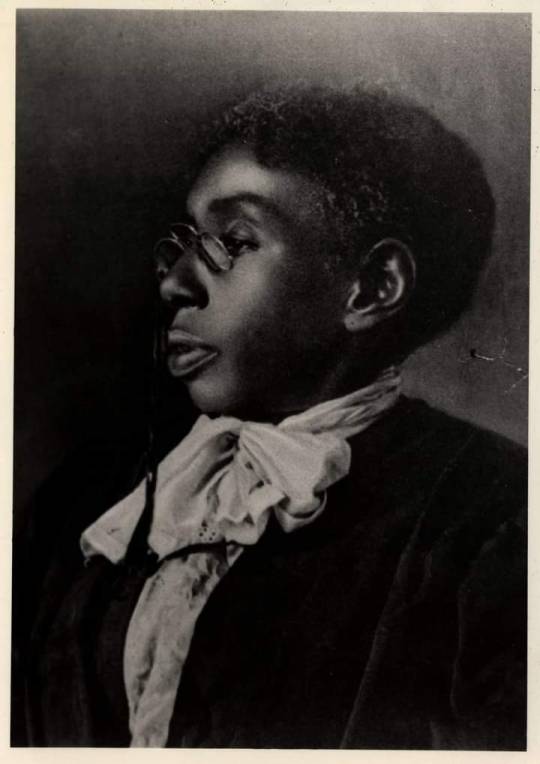
Jennie Dean founder of “Manassas Industrial School for Colored Youth" Jennie Serepta Dean (1848–1913)
She was born a slave in northern Virginia’s Prince William County, but by the late 1880’s she finagled enough money from people like tycoon Andrew Carnegie to build an entire educational campus: classrooms, dormitories, dining halls, libraries and shops to teach both academic classes and trades like carpentry, animal husbandry, cooking and sewing to male and female black students from across the region, who had few other options for continuing their education.
Opened in 1894 with a small group of students and lasting in various forms until the original buildings were torn down in the 1960’s, Jennie Dean’s “Manassas Industrial School for Colored Youth” is testament to one woman’s determination and leadership. Her legacy lives on through the hundreds of students she touched, and their families.
What vision she had. What persistence in the face of extraordinary odds, from “ordinary” obstacles such as lack of money to the everyday insults of segregation and discrimination. What a gift she gave to so many generations of classes.
Frederick Douglass himself delivered the school’s dedication ceremony address in September, 1894. Here’s what he said, noting the location near major Civil War battles fought over whether people in certain states had the right to own slaves:
“No spot on the soil of Virginia could be more fitly chosen for planting this school….it is a place where the children of a once enslaved people may realize the blessings of liberty and education.”
Before they were torn down,the Manassas Industrial School buildings housed segregated classes during decades of Jim Crow.
#black tumblr#black literature#black history#black excellence#black community#civil rights#black history is american history#black girl magic#blackexcellence365#black history month#black girl tumblr
197 notes
·
View notes
Text
Mourning Dress, British, 1894
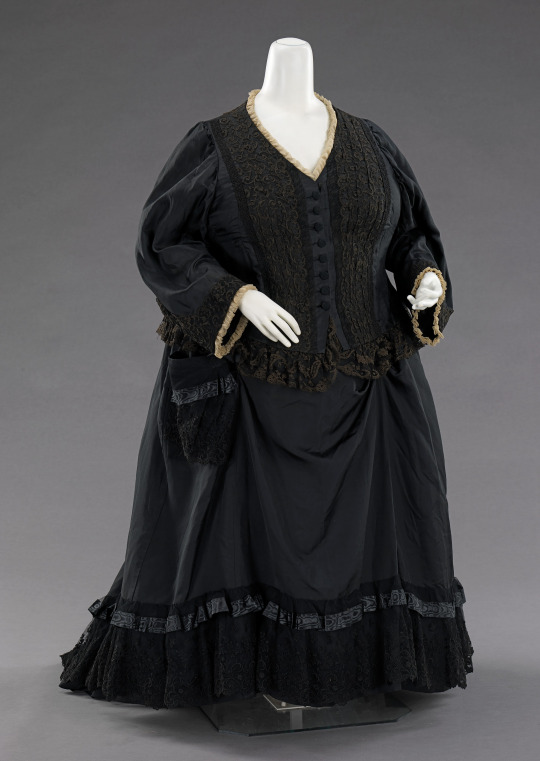
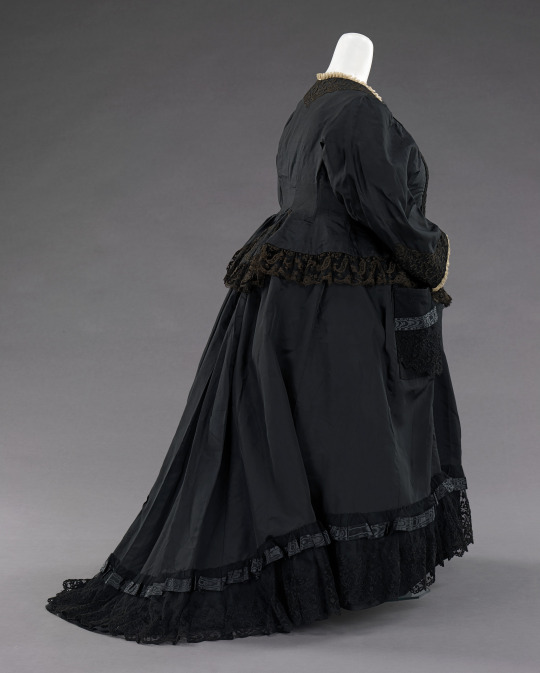
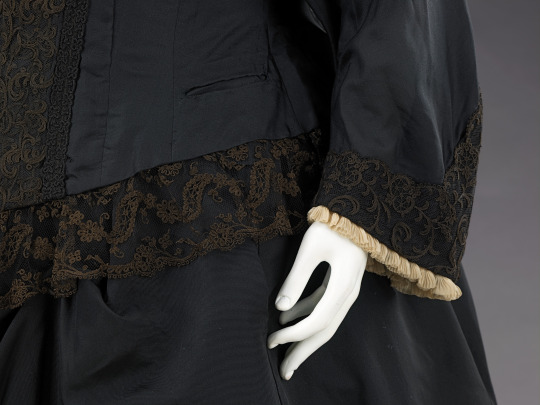
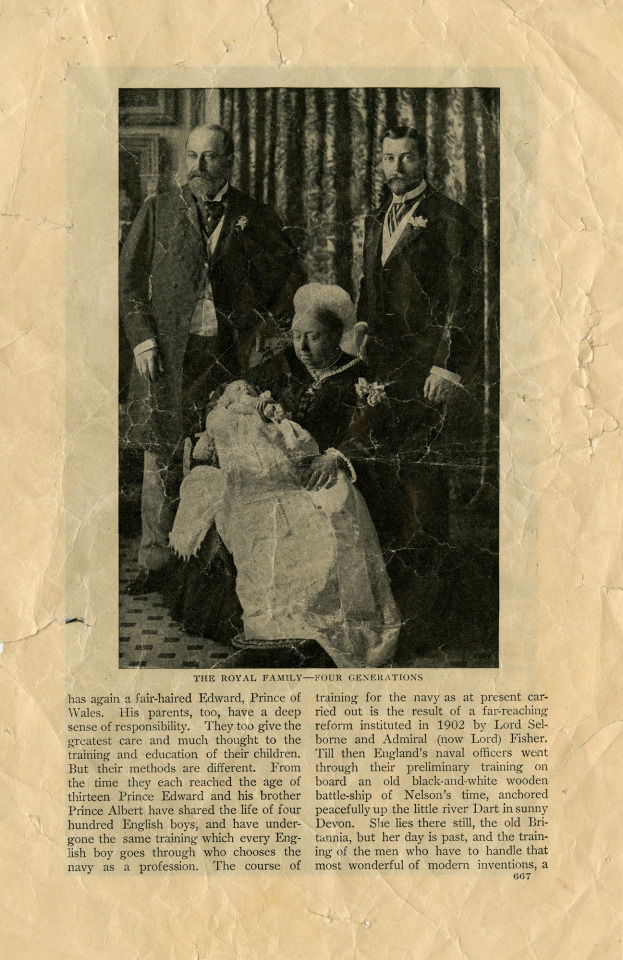
This dress was once worn by Queen Victoria (1819-1901) of the United Kingdom, as documented in an 1894 photograph of the Queen holding her great-grandson, Edward VIII (1894-1972). Purchased from an annual sale of the Queen's garments, it shows the traditional touches of mourning attire, which she wore from the death of her husband, Prince Albert (1819-1861), until her own death. The simple white trim and minimal use of crinkled crepe on the dress indicate a state of half mourning, although it is 33 years after her husband's death. The bodice is of a lighter material to allow for comfort during summer months and the entire garment is finely detailed inside and out. Black mourning dress reached its peak during Queen Victoria's reign. She set the standard by wearing mourning for half of her life. With these standards in place, it was considered a social requisite to don black from anywhere between three months to two and a half years while grieving for a loved one or monarch. The stringent social custom existed for all classes and was available at all price points. Those who could not afford the change of dress often altered and dyed their regular garments black. The amount of black to be worn was dictated by several different phases of mourning; full mourning ensembles were solid black while half mourning allowed the wearer to add a small amount of white or purple.
The MET Museum
193 notes
·
View notes
Text

Menu Monday: Although at many institutions, one wouldn't expect alumni to have a reunion a year following graduation, Princetonians have long been attached to each other and to their alma mater enough to warrant annual reunions. This is the menu for the Class of 1894's reunion in 1895. (It's their second annual dinner because their first was at the conclusion of their undergraduate careers.) Scrapbook Collection (AC026), Box 179
The entire Menu Monday series
6 notes
·
View notes
Text



This post translates directly to @musas-sideblog's about how Touchstarved ties with Victorian horror and implicit/metaphorical sex, and I couldn’t stop thinking about it, so here is a lengthy theory. Enjoy :)
Note 1: Victorian era authors used an unholy amount of ways to imply sexual feelings/acts etc, so I here I will include only the ones that are of interest. Note 2: I've highlighted the "most important" parts. Note 3: I'm not an expert at this, so please bear with me and feel free to correct me. Note 4: Do I need to add a TW? I think it's obvious-

Overview: What is Victorian Horror?
Victorian horror refers to the genre of horror literature, art, and culture that flourished during the Victorian era, roughly from the mid-19th century to the early 20th century, coinciding with Queen Victoria's reign from 1837 to 1901. This period was marked by a fascination with the macabre, the supernatural, and the dark aspects of human nature, reflecting the anxieties and societal changes of the time.
Key Themes and Characteristics
Supernatural Elements:
Ghosts and Spirits: Tales of haunted houses and spectral apparitions were central to Victorian horror. Charles Dickens's "A Christmas Carol" (1843) and Henry James's "The Turn of the Screw" (1898) are notable examples.
Monsters and the Gothic: The era's literature is filled with monstrous creations and gothic settings, such as in Mary Shelley's "Frankenstein" (1818), Bram Stoker's "Dracula" (1897), and Robert Louis Stevenson's "Strange Case of Dr Jekyll and Mr Hyde" (1886).
Science and the Unknown:
The Victorian period was a time of great scientific advancement, but also of fear about the implications of these discoveries. This is evident in works that explore the dangers of unchecked scientific experimentation, like "Frankenstein" and H.G. Wells's "The Island of Doctor Moreau" (1896).
Exploration of the Human Psyche:
Victorian horror often delved into the darker aspects of the human mind, including themes of duality, madness, and the hidden, sinister side of human nature. This is seen in "Dr Jekyll and Mr Hyde" and Edgar Allan Poe’s works, such as "The Tell-Tale Heart" (1843).
Social and Moral Anxieties:
The literature frequently reflected Victorian society's fears and anxieties, including issues related to sexuality, class, and the role of women. Gothic novels often contained subtexts about societal norms and the consequences of transgressing them.
Urban Fear and Isolation:
The rapid urbanisation of the Victorian era contributed to themes of isolation, alienation, and fear of the crowded yet lonely cityscape. This is evident in the settings of many horror stories, such as Arthur Machen's "The Great God Pan" (1894).
Sexual Content: Victorian literature is renowned for its strict moral codes and conservative views on sexuality. Explicit depictions of sexual activity were considered taboo and were subject to censorship. Consequently, authors developed subtle and nuanced methods to imply sexual scenes or themes.
Literary Techniques for Implying Sexual Scenes
✧ Symbolism and Imagery:
Sexuality was often conveyed through symbolic imagery. Objects, actions, or natural phenomena could serve as metaphors for sexual activity or desire. For example, in "Dracula" by Bram Stoker, blood and biting symbolise sexual penetration and the exchange of bodily fluids, infusing the act with a sense of forbidden desire and eroticism.
Clothing and Undress:
Gloves: In Victorian culture, gloves were highly symbolic. The act of a woman removing her gloves in the presence of a man, or a man assisting her in this act, could signify a moment of intimacy or vulnerability. Similarly, a man giving a woman his gloves could be a sign of affection or a deeper connection.
Hats and Bonnets:
Corsets
Objects and Personal Items:
Locks of Hair
Jewellery
Books and Letters
Touch and Physical Contact:
Kissing Hands
Hand-Holding
Food and Drink:
Wine: Sharing wine or a meal in an intimate setting often suggested a prelude to deeper connection. Descriptions of characters drinking wine together in private could imply a romantic or sexual undertone.
Fruit: Certain fruits, like apples, grapes, or peaches, were laden with sexual symbolism. Eating or sharing fruit could represent temptation or indulgence. For instance, in Christina Rossetti’s poem "Goblin Market", the act of eating the goblin fruit is rich with sexual symbolism.
Flora and Fauna
Flowers and Gardens:
Roses: Roses were often used to symbolise love and passion. A red rose might suggest romantic or sexual attraction, while a wilted rose could imply lost innocence or sexual ruin.
Lilies: Lilies, especially white ones, represented purity but could also suggest a contrasting theme when associated with a fallen or tarnished character.
Garden Settings: Scenes set in secluded gardens or amongst lush, overgrown vegetation often hinted at secret or forbidden encounters. Descriptions of characters wandering through or tending to gardens could imply sexual exploration or awakening.
Flowers Blooming or Opening: The blooming of flowers often represented sexual awakening or the act of losing one's virginity.
Nature Imagery:
Rivers and Water: Flowing water and rivers often symbolised sexual desire and the act of lovemaking. For instance, in "Tess of the d'Urbervilles" by Thomas Hardy, Tess's encounter with Alec d'Urberville is often described with metaphors of nature and fluidity.
Storms and Weather: Storms, with their intense energy and sudden outbursts, were frequently used to symbolise sexual passion or climactic moments.
Birds and Beasts:
Animals, especially those that are wild or predatory, often symbolised primal sexual instincts and desires. The taming or interaction with these animals could imply a character’s grappling with their own sexuality.
Fire and Heat
✧ Phrases and Sayings
Euphemistic Language
Descriptive Phrasing
Dialogue and Confessions
Private Spaces:
Secluded or Dimly Lit Rooms: Scenes set in private, darkened rooms often suggested clandestine sexual encounters. The privacy of the setting allows authors to imply what could not be explicitly stated. In Wilkie Collins’s "The Woman in White", many key interactions happen in secluded spaces, hinting at secrets and hidden desires.
Dreams and Fantasies:
Dream Sequences:
Dreams and fantasies were used to explore a character’s subconscious desires and fears, often revealing their suppressed sexual longings. These sequences provided a socially acceptable way to delve into erotic themes.
Hallucinations and Madness:
Moments of madness or hallucination could serve as a metaphor for overwhelming passion or uncontrollable sexual desire. These states allowed characters to express forbidden feelings in a way that was metaphorically safe.
Physical Interactions and Horror
Touch and Proximity as Menace:
Unwanted or Forced Touch: In horror, touch that is typically a sign of affection or intimacy becomes a source of fear.
Physical Closeness in Horror Settings: Close proximity in dark, secluded places amplifies the sense of claustrophobia and vulnerability, turning what could be an intimate setting into one fraught with terror.
Undress and Exposure in Horror:
Loosening Corsets and Vulnerability: The act of undressing or loosening clothing, which can be a prelude to intimacy, in horror often leaves characters vulnerable to attack or exposure of their deepest fears.
Food and Consumption in Horror
Cannibalism and Vampirism:
Blood as Sexual and Vital Fluid: The act of consuming blood, as in vampirism, blends the themes of sustenance and sexual exchange. The vampire's bite becomes a metaphor for both sexual penetration and the transfer of life force.
Example: "Dracula" is a prime example where blood consumption is deeply eroticized, with Dracula’s victims often portrayed in a state of ecstatic submission as he drains their blood.
Food as a Lure: Food and feasting, typically symbols of pleasure and indulgence, in horror contexts can be used to lure victims into dangerous situations.
Example: In "Goblin Market" by Christina Rossetti, the goblins’ fruit is both irresistibly tempting and dangerous, representing a forbidden and potentially fatal indulgence.
Plot and Character Dynamics in Horror
Power and Domination:
Common Dynamics with a Dark Twist
Predators and Victims: Characters who prey on others are often literal monsters in horror, representing the loss of control or innocence.
Secrecy and Concealment:
Hidden Desires and Monstrous Revelations: Characters who conceal their true identities or desires often find these hidden aspects manifesting as monstrous or terrifying in horror narratives, suggesting that repression can lead to dire consequences.
Clandestine Meetings and Forbidden Encounters: Secret meetings and forbidden relationships, often tinged with sexual implications, add an element of danger and fear, suggesting that transgressing social norms leads to horror.
Common Themes in Victorian Horror
Duality and the Doppelgänger:
Theme: The concept of duality, where a character has a hidden, darker side, or encounters a double (doppelgänger), often symbolises the internal conflict between good and evil within individuals.
Connection: This theme reflects Victorian anxieties about identity, morality, and the consequences of repressing one’s darker impulses.
Gothic and Supernatural Elements:
Theme: Victorian horror is rich with Gothic elements such as haunted houses, dark landscapes, and supernatural beings. These elements create a sense of dread and evoke the mysteries of the unknown.
Connection: The Gothic setting often serves as a backdrop for exploring human fears, isolation, and the impact of the supernatural on everyday life.
Decay and Degeneration:
Theme: The fear of decay and degeneration, both physical and moral, is a recurring motif. This theme often examines the decline of individuals, families, or societies and the consequences of corruption and vice.
Connection: This theme mirrors Victorian concerns about the erosion of social and moral values amidst rapid industrial and social changes.
Madness and Psychological Horror:
Theme: The exploration of madness and psychological horror delves into the fragility of the human mind and the terror of losing one's sanity. This often includes hallucinations, obsessions, and the thin line between reality and delusion.
Connection: This theme resonates with Victorian fears of mental illness, the limitations of medical knowledge, and the impact of societal pressures on mental health.
Forbidden Knowledge and the Faustian Bargain:
Theme: The pursuit of forbidden knowledge and the resulting consequences is a central theme. Characters who seek power, immortality, or forbidden truths often pay a heavy price, reminiscent of the Faustian bargain.
Connection: This theme highlights Victorian anxieties about scientific progress, moral boundaries, and the potential hubris of human ambition.
The Uncanny and the Unknown:
Theme: The uncanny involves the strange and unfamiliar becoming eerily familiar, often unsettling the reader and characters. It blurs the lines between reality and the supernatural, invoking fear and discomfort.
Connection: This theme taps into Victorian fears of the unknown, the foreign, and the otherworldly, reflecting broader anxieties about social and cultural boundaries.
Death and the Afterlife:
Theme: Victorian horror frequently grapples with themes of death and the afterlife, exploring the fear of mortality, the possibility of an afterlife, and encounters with the dead or undead.
Connection: These themes reflect Victorian preoccupations with death, the spiritual realm, and the possibility of life beyond death, often intensified by the era's high mortality rates and interest in spiritualism.
Isolation and Alienation:
Theme: Isolation and alienation are prevalent themes, often highlighting characters who are physically or emotionally detached from society, leading to their vulnerability and descent into despair or madness.
Connection: This theme resonates with the Victorian experience of industrialization and urbanization, which often led to feelings of disconnection and loneliness.
Class and Social Anxiety:
Theme: Victorian horror often explores themes of class and social anxiety, including the fear of losing social status, the consequences of poverty, and the tension between different social classes.
Connection: This theme reflects the rigid class structures of Victorian society and the fears and tensions that arose from social mobility and economic disparity.
Moral Corruption and Hypocrisy:
Theme: Victorian horror frequently critiques the era’s moral standards and exposes the hypocrisy of societal norms. Characters who appear virtuous often harbor dark secrets or engage in morally dubious activities.
Connection: This theme mirrors the Victorian concern with appearances and the underlying tension between public propriety and private desires.
The Five Pillars of Victorian Horror & The Five Love Interests
The Supernatural and the Gothic (Ais)
Essence: Victorian horror often revolves around the supernatural, blending Gothic elements to evoke a sense of dread and otherworldly terror. This includes ghosts, vampires, haunted houses, and curses, which create an atmosphere where the boundaries between the natural and the supernatural blur.
Impact: The use of Gothic settings and supernatural phenomena provides a backdrop for exploring deeper themes of fear, mortality, and the unknown.
Psychological Depth and Madness (Vere)
Essence: Victorian horror delves into the complexities of the human mind, exploring themes of madness, obsession, and the psychological effects of fear and trauma. Characters often grapple with their sanity, facing inner demons as terrifying as any external threat.
Impact: This focus on psychological horror allows for a deeper exploration of character motivations and the impact of societal pressures.
Moral Corruption and the Double Life (Leander)
Essence: Themes of moral corruption and the duality of human nature are central to Victorian horror. Characters often lead double lives, presenting a veneer of respectability while concealing dark, sinful secrets. This tension between outward appearances and hidden truths reflects the era’s social hypocrisy and fear of scandal.
Impact: These themes critique Victorian society’s emphasis on propriety and the dangerous consequences of repressing one’s true nature. The idea of a double life or hidden self adds to the horror by suggesting that evil can reside within anyone, masked by a facade of normalcy.
Decay, Degeneration, and Disease (Kuras)
Essence: The themes of physical and moral decay, societal degeneration, and disease permeate Victorian horror. These motifs symbolise the fragility of human life and the inevitability of decline, reflecting the anxieties of a society grappling with rapid change and uncertain futures.
Impact: By focusing on decay and degeneration, Victorian horror underscores the transient nature of life and the ever-present threat of corruption and decline, whether through ageing, moral compromise, or societal breakdown.
Isolation and Alienation (Mhin)
Essence: Isolation and alienation are pervasive themes in Victorian horror, often depicted through characters who are physically or emotionally cut off from society. This separation heightens their vulnerability to external threats and internal fears.
Impact: Isolation serves to intensify the psychological tension and sense of dread, as characters confront their fears alone. It also reflects the era’s social and existential anxieties, including the fear of being disconnected or outcast from society.

Generally, I believe each LI connects with a pillair (as seen above). Perhaps by looking at the archetypes we could deduce propable endings and route elements.
Forgive me, for the following part is MESSY;
Ais
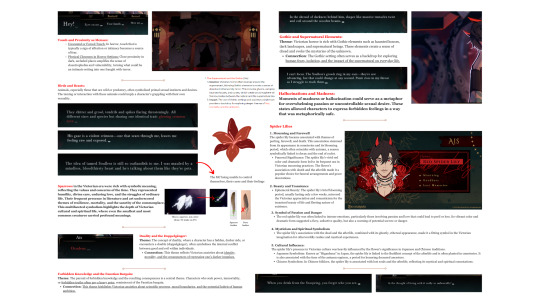
Vere
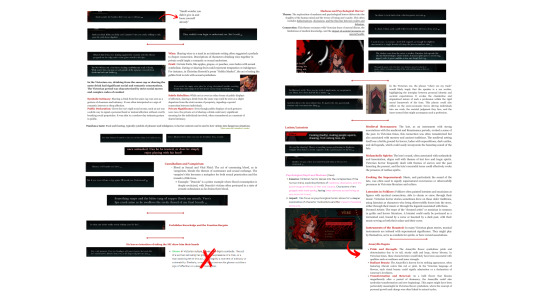
Leander
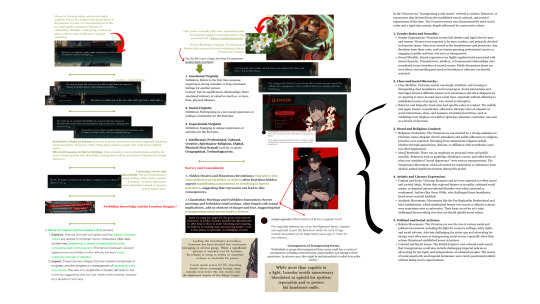
Kuras
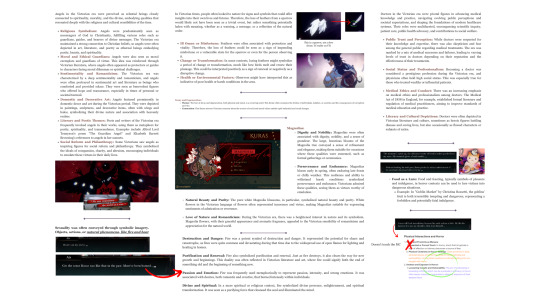
Mhin
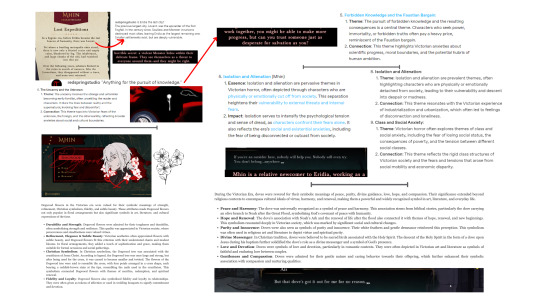

#THIS TOOK ME AGES#but it was worth it#vereletters#touchstarved theory#touchstarved theories#touchstarved ais theory#touchstarved vere theory#touchstarved kuras theory#touchstarved leander theory#touchstarved mhin theory#red spring studios#touchstarved#ts#touchstarved headcanons#touchstarved game#touchstarved oneshot#ais#ais headcanons#ais ts#ts ais#ais touchstarved#touchstarved ais#ais oneshot#vere#vere headcanons#vere ts#ts vere#vere touchstarved#touchstarved vere#vere oneshot
229 notes
·
View notes
Text
Writing Notes: The Uses of Slang

According to the British lexicographer Eric Partridge (1894–1979), people use slang for any of at least 15 reasons:
In sheer high spirits, by the young in heart as well as by the young in years; ‘just for the fun of the thing’; in playfulness or waggishness.
As an exercise either in wit and ingenuity or in humour. (The motive behind this is usually self-display or snobbishness, emulation or responsiveness, delight in virtuosity.)
To be ‘different’, to be novel.
To be picturesque (either positively or – as in the wish to avoid insipidity – negatively).
To be unmistakeably arresting, even startling.
To escape from clichés, or to be brief and concise. (Actuated by impatience with existing terms.)
To enrich the language. (This deliberateness is rare save among the well-educated, Cockneys forming the most notable exception; it is literary rather than spontaneous.)
To lend an air of solidity, concreteness, to the abstract; of earthiness to the idealistic; of immediacy and appositeness to the remote. (In the cultured the effort is usually premeditated, while in the uncultured it is almost always unconscious when it is not rather subconscious.)
(a) To lessen the sting of, or on the other hand to give additional point to, a refusal, a rejection, a recantation; (b) To reduce, perhaps also to disperse, the solemnity, the pomposity, the excessive seriousness of a conversation (or of a piece of writing); (c) To soften the tragedy, to lighten or to ‘prettify’ the inevitability of death or madness, or to mask the ugliness or the pity of profound turpitude (e.g. treachery, ingratitude); and/or thus to enable the speaker or his auditor or both to endure, to ‘carry on’.
To speak or write down to an inferior, or to amuse a superior public; or merely to be on a colloquial level with either one’s audience or one’s subject-matter.
For ease of social intercourse. (Not to be confused or merged with the preceding.)
To induce either friendliness or intimacy of a deep or a durable kind. (Same remark.)
To show that one belongs to a certain school, trade, or profession, artistic or intellectual set, or social class; in brief, to be ‘in the swim’ or to establish contact.
Hence, to show or prove that someone is not ‘in the swim’.
To be secret – not understood by those around one. (Children, students, lovers, members of political secret societies, and criminals in or out of prison, innocent persons in prison, are the chief exponents.)
From Slang: Today and Yesterday, 1933, Ch. 2.
Source ⚜ More: Word Lists ⚜ Notes & References
#writing reference#worldbuilding#writeblr#langblr#dark academia#spilled ink#literature#writers on tumblr#language#linguistics#writing prompt#poets on tumblr#poetry#words#creative writing#fiction#light academia#writing inspiration#writing ideas#nature#federico zandomeneghi#writing resources
78 notes
·
View notes
Text
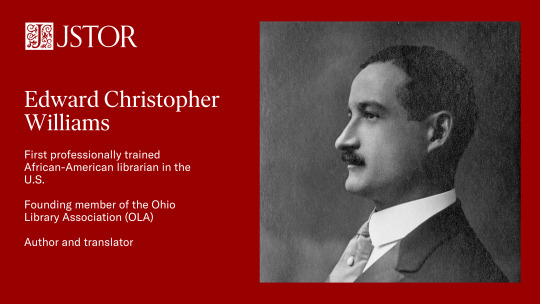
Edward Christopher Williams (11 Feb. 1871 - 24 Dec. 1929) was a pioneering African American librarian, educator, and scholar who played a vital role in shaping library collections at Western Reserve University (WRU) and Howard University. Born in Cleveland to Daniel P. Williams, a prominent African American figure, and Mary Kilkary Williams, a Clevelander of Irish descent, Williams embarked on a remarkable journey of academic and professional achievement.
Graduating from Adelbert College of WRU in 1892, Williams quickly made his mark as he assumed the role of first assistant librarian at the institution. His dedication and expertise saw him ascend to the position of head librarian in 1894 and university librarian in 1898. Eager to deepen his knowledge, Williams pursued further studies in library science at the New York Library School in Albany, completing the rigorous 2-year program in just one year.
Williams's impact on WRU's library was profound; he significantly expanded its collection and elevated its standards, establishing himself as an authority in library organization and bibliography. His advocacy for the establishment of a school of library science at WRU led to its inception in 1904, where he became an esteemed instructor, offering courses in reference work, bibliography, public documents, and book selection.
A founding member of the Ohio Library Association, Williams played a pivotal role in shaping its constitution and direction. However, in 1909, he left Cleveland to assume the role of principal at M St. High School in Washington, D.C. His tenure there was marked by his unwavering commitment to education and leadership.
In 1916, Williams joined Howard University as university librarian, further cementing his legacy in the realm of academia. Not only did he oversee the university's library, but he also directed Howard's library training class, taught German, and later chaired the Department of Romance Languages.
In pursuit of academic excellence, Williams embarked on a sabbatical in 1929 to pursue a Ph.D. at Columbia University. Tragically, his studies were cut short by his untimely passing later that year.
In 1902, Williams married Ethel P. Chesnutt, the daughter of Charles Chesnutt, a renowned author. Their union bore one son, Charles, who would carry on his father's legacy in the years to come.
Read more about Edward Christopher Williams here.
306 notes
·
View notes
Text
From the Seattle IWW, written by FW Noah in 2022: "The True History of May Day."
In the United States and many other countries, there are labor days that celebrate the working class contributions to the economy, the infrastructure, and the nation as a whole. While many of these holidays give great praise and pomp towards working class people, they often overlook the history that led up to the foundation of such celebrations, and what the foundations were really laid upon. Much of the early labor history is filled with great strife, conflict, death and destruction often directed towards working class individuals, who attempted to organize their lives in a way to break off the shackles of exploitation and capitalism as a whole. May Day began as a remembrance of the Haymarket Affair of 1886, when several anarchists who were supporting a protest for the 8 hour day in the city of Chicago were falsely accused by the police of detonating a bomb, and were executed as a result despite nationwide demands for their clemency. Since that day, every May the 1st became a day of celebrating the toil and contributions of workers in society and the struggle for better working class conditions, and uplifted the voices of those who were often marginalized or ignored by the upper classes. However, the United States of America has a different official Labor Day, established by the federal government in 1894. The change in date was intended to distract workers from the more radical origins of the holiday. This began a trend in the larger labor movement away from uniting the working class as one body with common interests and towards formalizing relations between a disadvantaged class and those with the power and wealth to decide the course of negotiations.
172 notes
·
View notes
Text




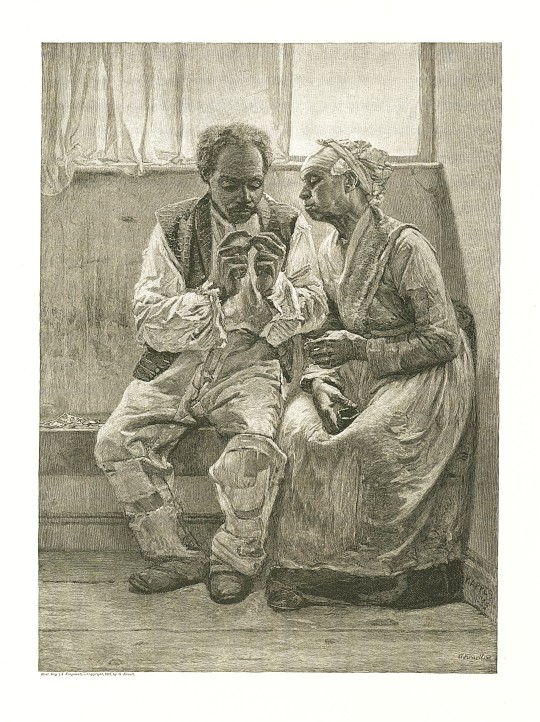
Wood Engraving Wednesday
GUSTAV KRUELL
The nineteenth century was the age of the great commercial wood engravers who produced images for newspapers, magazines, catalogs, advertising, and book illustration, often as reproductions from photographs and paintings. Among the leading wood engravers in the United States during this period was German-American Gustav Kruell (1843-1907) who co-founded the Society of American Wood Engravers, which lasted from 1881 to 1902. Among his most notable engravings is this print entitled Rent Day, produced in 1887 after a painting by the American illustrator and genre painter Alfred Kappes (1850-1894).
This print is reproduced in Engravings on Wood by Members of the Society of American Wood-Engravers by American newspaper publisher and art enthusiast William M. Laffan (1848-1909), published in New York by Harper and Brothers in 1887. Laffan offers an unashamedly jingoistic view of the superiority of American wood engraving:
In Europe the largest and the most distinct style of engraving upon wood is that of the French school. . . . There is There is mind in the line of the French engraver, and a splendid audacity in his treatment that fills would-be imitators with dismay, but a German engraver has no ideas of his own, and is the slave of his technical limitations. [The American engraver] has achieved a character more original and pronounced, and more nearly national, than any other. . . . The work of the American wood-engraver has a distinction that is original with itself.
Of Kruell's rendering of Rent Day, Laffan writes:
Mr. Kruell deals with a subject of a different class, and displays his versatile mastery of technique of his art. It is an exceedingly delicate and faithful translation of bold and difficult color values, and as a truthful and pleasing reproduction of the original is a fine example of wood-engraving and of Mr. Kruell's best work.
Our copy of Engravings on Wood is another gift from our friend Tony Drehfal, a leading member of the contemporary counterpart to the Society of American Wood Engravers, the Wood Engravers' Network.
View more posts with wood engravings!
#Wood Engraving Wednesday#wood engravings#wood engravers#Gustav Kruell#Rent Day#Society of American Wood Engravers#Engravings on Wood#William M. Laffan#Harper and Brothers#commercial wood engraving#19th century wood engraving
93 notes
·
View notes
Photo
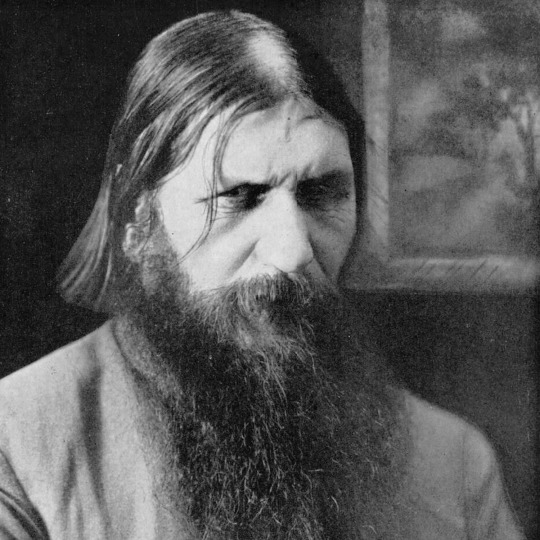
Grigori Rasputin
Grigori Rasputin (1869-1916) was a self-styled holy man and faith healer from Siberia who ingratiated himself with the family of Tsar Nicholas II (reign 1894-1917). Rasputin was particularly valued by the empress Alexandra Feodorovna (1872-1918) because it seemed he could help her son and heir to the throne, Alexei, who suffered from haemophilia. Rumours of Rasputin's loose living and concerns over just how much influence he had in the halls of power eventually led to his assassination by a group seeking to protect the already waning prestige of the autocratic Romanov dynasty.
Early Life & Appearance
Grigori Efimovich Rasputin was born in Pokrovskoe, a village in Siberia, in 1869. The name Rasputin was later identified with the Russian word for 'libertine', but this was part of the mythology that surrounded this controversial figure, since Rasputin was his father's name and not chosen by him, as some have reported. Born into the peasant class, Grigori stole horses according to legend (although no police records exist to that effect) before settling down to marry a local peasant girl, Praskovia Dubrovina, with whom he had several children.
Rasputin became a starets, that is, a sort of wandering, unordained holy man and faith healer. He embarked on several pilgrimages but did not adhere to an ascetic lifestyle like most starets. As the historian A. Wood summarises: "Rasputin was not, as he is often described, a 'mad monk' but a member of an extreme religious sect of sexually promiscuous flagellants in Siberia known as khlysty." (37). This membership is, in fact, also disputed. As the historian S. S. Montefiore states, "he was not a member of the sect and denied any connection" (535), a position repeated by D. Smith in his biography of Rasputin. More certain is that during his travels, Rasputin became highly skilled at reading people psychologically and offering them suitable advice, usually couched in a vague quasi-religious speech sprinkled abundantly with biblical quotes and folk proverbs.
Rasputin was a physically striking person, tall and with long hair and a long beard, usually neatly trimmed and well-combed. He had deep-set grey-green eyes and a penetrating, mystical gaze. One of Rasputin's friends (and many others, both men and women) recorded the striking effect of the Siberian's eyes: "The charm of this man lies in his eyes. There is something in them that draws you in and forces you to submit to his will. There is something psychologically inexplicable in all this" (Smith, 105). Some women said that Rasputin's stare seemed all-knowing or even made them want to scream.
Rasputin's voice was ordinary enough, but his odd words were usually accompanied by equally odd or esoteric gestures and a constant movement of the fingers. He was extremely tactile, often touching people's hands and kissing women. Unlike the uncharitable press reports, Rasputin was clean and trim in appearance, points noted by many of those who actually met him.
Read More
⇒ Grigori Rasputin
58 notes
·
View notes